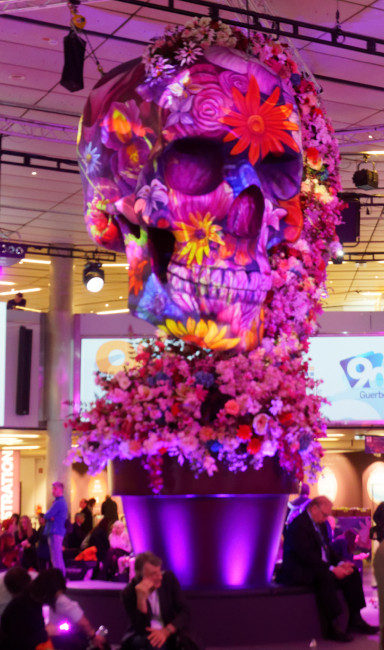 This impressive projection mapped display welcomed delegate at ECR 2017. I’m not sure that the skull gave the kind of positive message, but delegates are mainly radiologists, so may see it differently! Image:MekoThe ECR in Vienna was a bit quiet this year, compared to previous events. Partly it was because we arrived on the Saturday because of the clash with MWC this year. A problem with the flight out meant that we were very tight for time, but found no problem in getting round in just a couple of hours. Each of the last three years has seen fewer exhibitors in the display category as the market has slowed down. There are only a few tenders now in Western Europe, where we are now into a period where the market is just for replacements. The areas to the East and in the Middle East and Africa are suffering from low oil prices, so there is a bit of a lull in those regions.
This impressive projection mapped display welcomed delegate at ECR 2017. I’m not sure that the skull gave the kind of positive message, but delegates are mainly radiologists, so may see it differently! Image:MekoThe ECR in Vienna was a bit quiet this year, compared to previous events. Partly it was because we arrived on the Saturday because of the clash with MWC this year. A problem with the flight out meant that we were very tight for time, but found no problem in getting round in just a couple of hours. Each of the last three years has seen fewer exhibitors in the display category as the market has slowed down. There are only a few tenders now in Western Europe, where we are now into a period where the market is just for replacements. The areas to the East and in the Middle East and Africa are suffering from low oil prices, so there is a bit of a lull in those regions.
There was general agreement that multi-modality displays are getting more and more popular and we also heard that in some hospitals, there is a tendency to try to afford to buy all diagnostic monitors, rather than a mix of review and diagnostic models so that any display can be used for anything. That’s partly because new hospitals are not being built and often space is at a premium. On the other hand, others told us that what tender business there is, is especially competitive at the moment. One vendor told us that “80% to 90%” of the decision is based on cost. We heard that even brands with strong reputations (no names here!) are proving capable of being quite aggressive on price, to maintain market share and some volume.
The trend to colour has been a steady one and last year, Jusha told us that it had a patent on having a colour monitor that automatically detected a DICOM grey scale image and set the mode appropriately. However, this time, Totoku told us that it had this feature and as we had spoken to them before Jusha, we asked Jusha about the patent. The staff member that we spoke to didn’t know of the patent, so maybe it wasn’t granted? The regulations that stipulate DICOM compatibility enable the market, but also limit. Radiography images at up to 3 megapixels are standardised now, so there is little chance of going to higher resolution. As we heard last year, there may be little reason if the detectors don’t get better.
A move to adopt standardised colour, something similar to DICOM would help the market, but we were unable to get much information at the event about progress as the event is largely staffed by sales and marketing people (expecially, it seemed, at the weekend!) and it’s the engineers that work with the standards committees. Nobody that we spoke to was very optimistic about a standard soon.

